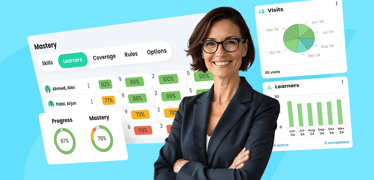A corporate trainer at a fast-growing startup struggles to foster collaboration among remote employees during onboarding. They’ve tried a few solutions, but the broader team wants a platform that enco...

Teams that want to get ahead–in employee mobility, innovation, and market share are increasingly leaning into data-driven approaches. By leveraging data-driven insights, you can make smarter decisions...

The "new normal" has already set in, and organizations are facing challenges we've known about for a while, such as managing a remote workforce. Other struggles, like the battle for top talent, have r...

If there’s one word that sums up the reality of managing today’s workforce, that word is challenging. An early 2025 Gallup report found that 51% of employees are actively looking for new job opportuni...

Workplace learning has undergone a total makeover in recent years. Outdated training manuals and dull Zoom sessions have been swapped for more relevant industry content, immersive simulations, and bit...

Educators and corporate trainers share a common challenge: to keep learning engaging and effective in a digital world that never seems to stop advancing. As organizations continue to prioritize learni...

Enterprise training is a company-wide approach to skill development that ensures employees at all levels have access to the same knowledge and resources. That’s a winning scenario, especially when wor...

A business is only as strong as its employees. Keeping your team skilled, engaged, and adaptable is key to long-term success—and that’s where employee training software comes in. The right platform ma...

Companies spend billions on corporate training, to the tune of over $1,200 per employee in 2023. But too often, the results from so much in-depth training fall short. That’s where performance-based tr...

Upskilling is more than a buzzword. It’s a golden strategy for brands that are serious about helping their companies and existing employees grow personally and professionally. In fact, companies world...

Today’s business trainers are navigating a workplace where demands and expectations–both from corporations and employees–can change faster than ever. Employees expect engaging, impactful learning expe...

Let’s face it—traditional training methods just can’t keep up with the demands of today’s workforce. It’s slow, inefficient, and leaves skills gaps that your organization can’t afford. But there’s goo...

Imagine this: your corporate team is onboarding a group of new hires across different regions, and they’re all buzzing with questions. A robust LMS can be the difference between a seamless, engaging t...

Enterprise learning management systems are essential for continuous learning—among staff, partners, and even customers. For HR professionals and corporate trainers, having an LMS that checks the boxes...

Canvas by Instructure is an extremely popular learning management system (LMS). As a top LMS choice for schools, colleges, and universities, thousands of instructors and learners use Canvas to impleme...

